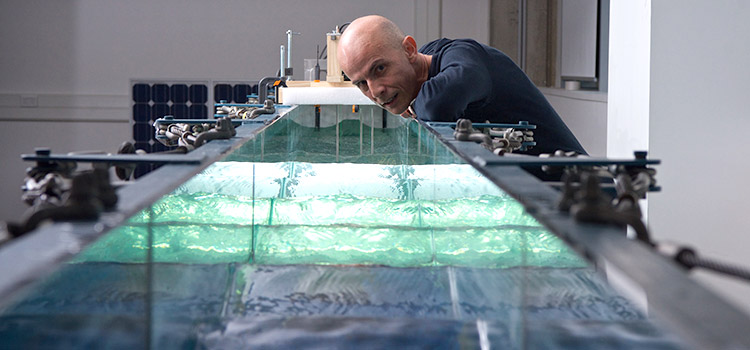Surf sounds study to investigate bubble size data for industrial and environmental use

Professor Richard Manasseh will use the wave channel in Swinburne’s Energy Transformation Lab to study the dynamics of bubbles in waves.
In summary
- Swinburne researchers are studying the sound dynamics of bubbles in waves
- These sounds contain valuable data that has applications in many industries as well as in determining how much carbon dioxide the Earth’s oceans are absorbing
- Elissa Goodrich will work with the Surf Sounds team to create new music and sound art
From the ‘plink’ of a single drop of liquid falling into a glass of water to the roar of ocean surf, the formation of bubbles makes sounds familiar to everyone.
These sounds contain valuable data on bubble sizes and numbers that have applications not only in many different industries, but also in determining how much carbon dioxide the Earth’s oceans are absorbing.
Funded by a $525,000 Australian Research Council Discovery Project grant, Swinburne University of Technology researchers are studying the dynamics of bubbles in waves.
“We think that bubbles in breaking ocean waves facilitate the absorption of up to a third of global carbon dioxide emissions, but the true fraction the ocean absorbs is poorly understood, adding to uncertainty in climate-change models,” says lead researcher Professor Richard Manasseh.
“Bubble size also matters in industries that rely on pumping air into liquid, including processed-food and pharmaceuticals manufacturing, rare-earth metals refining and recycling.”
Bubble size controls the rate with which oxygen or other gases are absorbed by water or other liquids. At present measuring bubble size is virtually impossible in most practical industrial and environmental situations.

Dr Filippo Nelli is working on simple lab experiments to understand the relationship between the size of bubbles and the sound amplitude made as they are formed.
The relationship between bubble size and sound frequency – the ‘pitch’ of the ‘musical note’ made by bubbles – has been understood since the 1930s, but uncertainty on the sound amplitude or volume has made sound recordings impossible to interpret.
Dr Filippo Nelli has been recruited as a postdoctoral researcher and is working on simple lab experiments to understand the relationship between the size of bubbles and the sound amplitude made as they are formed. The study of five different bubble formation processes will create a database.
At the same time, Professor Andrew Ooi at the University of Melbourne will use a supercomputer to simulate numerically what is being measured in the lab.
The goal is to develop instruments to monitor these processes, permitting their ultimate control.
“Australian instrument manufacturers would gain a potential new product and Australian minerals, food, pharmaceutical and environmental-monitoring industries would be the first to benefit,” Professor Manasseh says.
Waves music project
In a creative adjunct to the Surf Sounds project, Melbourne composer, sound artist and musician Elissa Goodrich has been awarded an Australia Council for the Arts grant to work on a musical interpretation of the bubble acoustics research. Ms Goodrich specialises in using music to interpret science for the public and was recently made a Swinburne Visiting Fellow.

Elissa Goodrich will work with the Surf Sounds scientific team to create new music and sound art that conveys climate science's vital themes and modellings of tipping points and thresholds.
“I am very excited to be able to work as an embedded artist with Richard's Surf Sounds project and to be doing this in a longitudinal approach,” Ms Goodrich says.
As her musical composition ideas develop, she will introduce a small ensemble of musicians with expertise in contemporary improvised music, to develop a full length musical work for live contemporary jazz/classical ensemble and electro-acoustic sound art.
-
Media Enquiries
Related articles
-

- Student News
- Science
- Sustainability
Introducing tomorrow’s global science communicators
Start Talking is Swinburne’s unique video-based public speaking competition, exclusively for undergraduate students
Monday 08 December 2025 -

- Technology
Swinburne-led network to guide AI use in youth services
Swinburne’s Dr Joel McGregor, Dr Linus Tan and Dr Caleb Lloyd have established the Responsible AI in Youth Sectors Network. The collaborative network aims to guide the fast-growing use of artificial intelligence in youth services across Victoria.
Friday 12 December 2025 -

- Astronomy
- Technology
- Health
- Science
- University
- Sustainability
- Engineering
Swinburne highly cited researchers reach the top in 12 fields
Ten Swinburne academics have been named on the Highly Cited Researchers 2025 list, released by Clarivate
Tuesday 02 December 2025 -

- Science
- Engineering
Swinburne secures grant to advance next-generation metamaterials research
Swinburne physicist Dr Weibai Li has received a Discovery Early Career Researcher Award from the Australian Research Council
Tuesday 02 December 2025 -

- Technology
- Health
- Science
- University
$1.2m ARC funding to boost national X-ray spectroscopy capability through Swinburne and QUT partnership
Swinburne has secured $1.2 million in the latest Australian Research Council Linkage Infrastructure, Equipment and Facilities scheme round
Tuesday 02 December 2025

